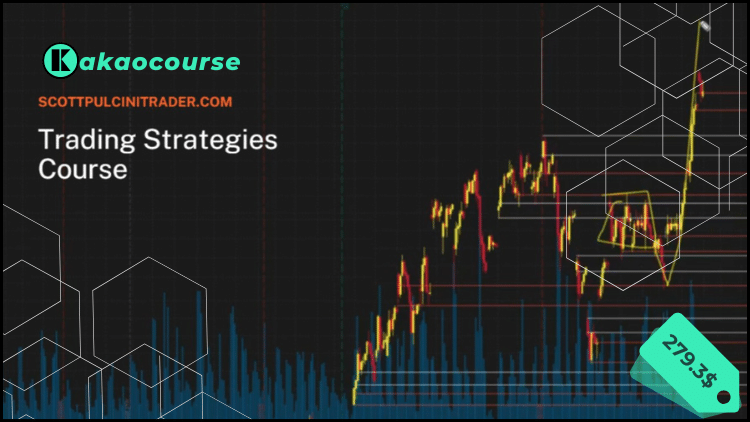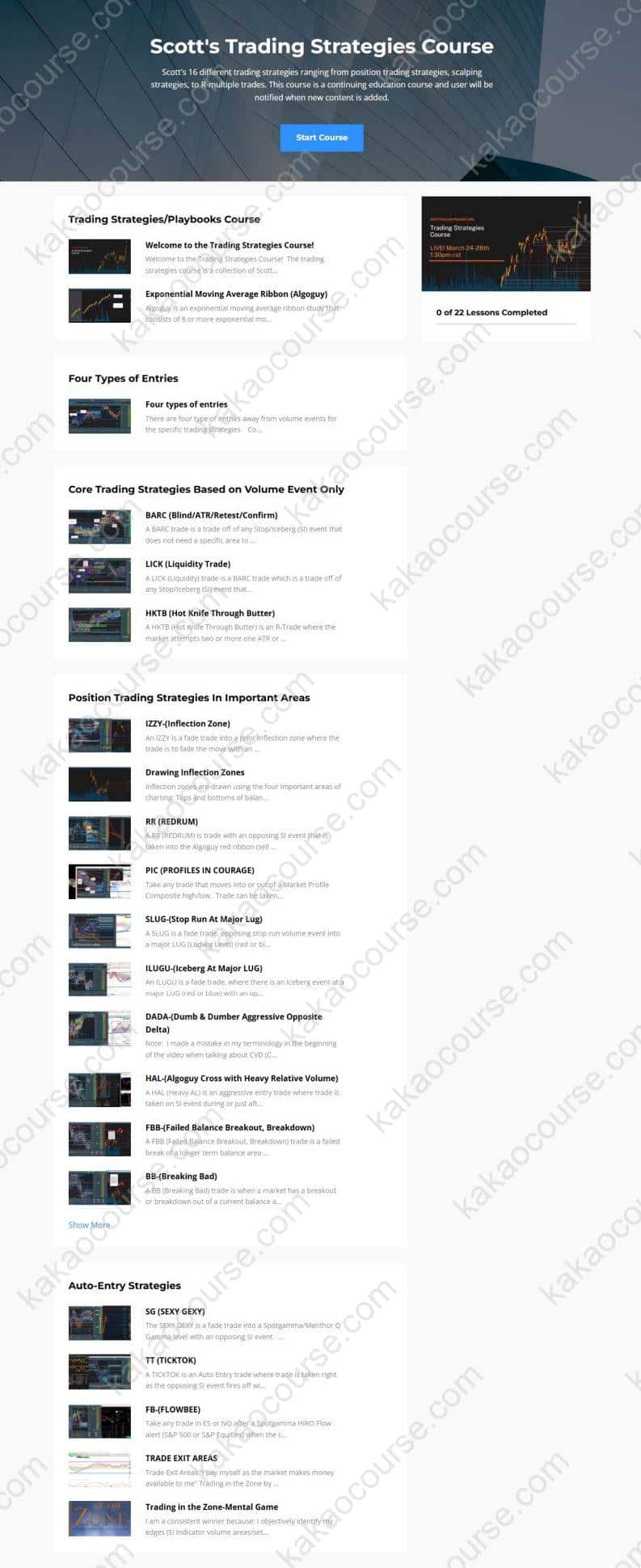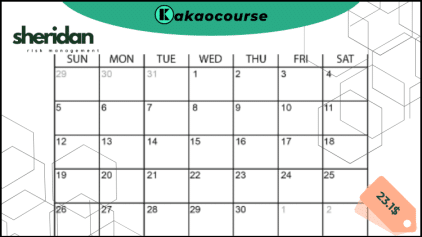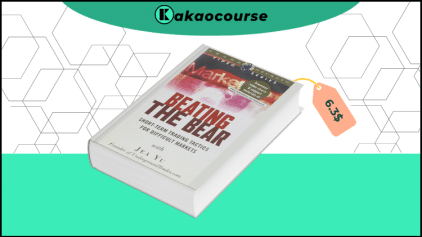Instant Download Scott’s Trading Strategies Playbooks Course by Scott Pulcini – Here’s What You’ll Get Inside:
Scott’s Trading Strategies Playbooks Course by Scott Pulcini, Check Out the Full Course Contents:
Scott’s Trading Strategies Playbooks Course by Scott Pulcini, Watch This Free Video Sample to Learn More:
Scott’s Trading Strategies Playbooks Course by Scott Pulcini, Free PDF Preview Available Below:
Overview this course
“Scott’s Trading Strategies Playbooks Course” distills more than seven hours of practitioner-level instruction from order-flow expert Scott Pulcini into a focused, international-friendly learning experience. Across sixteen battle-tested strategies, you’ll see how Scott frames the market, defines risk, and times entries using his Stop/Iceberg methodology—then reinforces each concept with rules, visual examples, and answers to live questions captured during filming.
This course is designed to feel like an organized trading lab: short, digestible modules, crystal-clear checklists, and repeatable playbooks you can rehearse before the market opens. Rather than overwhelming you with theories, Scott concentrates on where decisions are made—at liquidity, inflection, and volume events—so you can translate the material into a structured routine.
You won’t find hype here. You’ll learn a disciplined method for reading behavior at key levels, constructing trades with defined risk, and exiting deliberately—skills that are relevant across indices, futures, and highly liquid instruments.
Why should you choose this course?
Choosing a trading course is like choosing an operating system for your market decisions. This program stands out because it is strategy-first and process-driven.
-
Sixteen playbooks, one cohesive framework. Each strategy fits into Scott’s overarching Stop/Iceberg logic, so you build a system—not a collection of random tricks.
-
Market structure meets order-flow. You’ll connect moving-average context and volume/Delta behavior with actual execution rules at specific price zones.
-
Concrete entry and exit logic. You’ll practice four distinct entry archetypes and learn how to plan exits in advance—no guessing mid-trade.
-
Clarity at the hard moments. Modules on “Trading in the Zone” convert psychology into practical routines you can follow on volatile days.
-
Designed for international learners. Neutral language, globally applicable concepts, and a compact format that respects busy schedules.
-
Replayable and reference-ready. The playbook organization makes it easy to revisit rules quickly before a session or during a review.
If you’re tired of abstract lectures that don’t tell you how to act when tape speed changes, liquidity shifts, or an iceberg hits the book, these playbooks are built for you.
What You’ll Learn
You’ll progress from foundational context to specific tactics—then into exits and mindset—so that every trade you plan has a beginning, middle, and end.
1) Build your market context
-
EMA Ribbon (Algoguy): Use an exponential moving-average ribbon not as a “signal” but as a context lens for trend strength, slope, and pullback quality. Learn how ribbon compression/expansion helps you anticipate when a trend is likely to continue or stall.
-
Four Entry Archetypes: Master four clearly defined entry categories (e.g., blind, retest, confirm, and ATR-based styles) so you can match tactics to conditions instead of forcing the same entry everywhere.
-
Volume-Event-Only Logic: Recognize the cause behind price moves. You’ll learn to anchor setups to discrete volume or Delta events—where commitment becomes visible—rather than chasing candles.
2) Volume-event core strategies (Playbooks)
-
BARC (Blind / ATR / Retest / Confirm): A framework that maps your entry aggressiveness to market clarity. You’ll practice when to act immediately vs. when to wait for confirmation without losing the edge.
-
LICK (Liquidity Trade): Learn to spot resting liquidity and the behaviors around it—tap, absorb, reclaim—so you can lean on the order book rather than trading into thin air.
-
HKTB (Hot Knife Through Butter): Identify momentum phases where price slices through prior balance with conviction. You’ll cover criteria for continuation vs. snap-back risk and how to scale with discipline.
3) Position strategies at important areas
-
IZZY (Inflection Zone): Define and draw Inflection Zones with repeatable rules so your plan focuses on locations where responses are statistically meaningful.
-
RR (REDRUM): A momentum-through-risk concept: learn when pressure is one-sided, how to frame risk tightly, and how to avoid fading strong transitions.
-
PIC (Profiles in Courage): Balance and profile-based setups for rotational markets—when patience, inventory reads, and profile edges matter more than speed.
-
SLUG (Stop Run at Major LUG): Turn stop runs at large liquidity/levels into opportunity by distinguishing true capitulation from simple noise.
-
ILUGU (Iceberg at Major LUG): Read iceberg absorption at critical levels and plan entries that align with hidden size rather than fighting it.
-
DADA (Dumb & Dumber Aggressive Opposite Delta): Spot exhaustion when aggressive opposite Delta pushes into an area that refuses to break—then structure a contrarian entry with strict invalidation.
-
HAL (Algoguy Cross + Heavy Relative Volume): Combine a fast context shift (EMA cross) with unusual relative volume to isolate momentum entries that are more than just a moving-average signal.
-
FBB (Failed Balance Breakout/Breakdown): Recognize fake breaks from balance and how to fade them with risk defined behind the failure point.
-
BB (Breaking Bad): A deterioration pattern: when a healthy auction stops behaving, you’ll learn the checklist for transitioning from pullback-buying to breakdown tactics.
-
BA (Breaking Away): A clean escape from congestion—criteria for when a move is likely to hold, where to add, and where to walk away.
4) Auto-entry strategies (systematized triggers)
-
SG (Sexy Gexy): A systematic entry logic that combines flow/context into auto-triggers so you don’t hesitate when the conditions you’ve defined actually appear.
-
TT (TICKTOK): A rhythm-based approach that respects time-of-day and market tempo, helping you execute during windows when your edge is highest.
-
FB (Flowbee): A flow-sensitive entry that simplifies action when multiple confirms align (e.g., Delta behavior + location + structure).
5) Trade exit areas
-
Translate “never know where to exit” into a set of pre-planned exit zones: opposing inflection, reclaimed liquidity, failed continuation, and exhaustion tells.
-
Build laddered targets that reflect auction structure, not arbitrary R multiples.
-
Apply review loops: tag your exits (too early, good, too late) and refine rules with evidence.
6) Trading in the Zone – Mental Game
-
Convert mindset from motivational quotes to operational habits: pre-market rehearsal, intention setting, post-trade debriefs.
-
Create a rules hierarchy (location → trigger → risk → management) to reduce decision noise during volatility.
-
Use if/then protocols for common stress scenarios: missed entry, slippage, fast trend extensions, unexpected chop.
Who Should Take This Course?
This course serves traders who want structure, repetition, and accountability in their process:
-
Order-flow curious traders who want to connect tape/Delta/volume events with an execution plan.
-
Discretionary futures and index traders seeking playbooks that adapt to volatility without abandoning risk discipline.
-
Strategy collectors ready to consolidate into one cohesive framework—stop juggling stand-alone patterns and start thinking in location-trigger-risk sequences.
-
Professionals with limited time who need a replayable reference: open the module, review the checklist, execute.
-
Technically minded learners who enjoy clear acronyms, labeling, and rule-based decision trees.
-
Experienced traders who want to stress-test their current approach against volume-event logic and upgrade exits.
If you value clarity over hype—and you’re willing to practice rules until they feel automatic—these playbooks will meet you where you are and help you professionalize your routine.
What’s inside this course (at a glance)
You’ll get a complete toolkit that moves from context to tactics to review—without fluff.
-
Trading Strategies / Playbooks Orientation: How the course is structured and how to integrate it into a daily routine.
-
EMA Ribbon (Algoguy) Context Module: Use EMAs as a behavior filter, not a buy/sell button.
-
Four Entries, Clearly Defined: From aggressive to conservative—how to choose the right approach for the situation.
-
Volume-Event Core Setups: BARC, LICK, HKTB—how to recognize, plan, and execute each one.
-
Positioning at High-Importance Areas: IZZY zones, drawing rules, and level selection that stays consistent across instruments.
-
Behavioral/Flow Strategies: RR, PIC, SLUG, ILUGU, DADA, HAL, FBB, BB, BA—each with criteria, invalidation, and management rules.
-
Auto-Entry Methods: SG, TT, FB—systematized triggers that reduce hesitation.
-
Exit Architecture: Build target ladders and identify failure conditions early.
-
Mental Game: Turn emotions into checklists and daily habits.
Key outcomes you can expect (educational)
By the end, you will be able to:
-
Diagnose context using EMA ribbon behavior and relative volume so you don’t take strong-trend tactics into balance.
-
Locate trades at Inflection Zones and liquidity pockets instead of hunting entries in the middle of nowhere.
-
Select entries from four archetypes with confidence, aligning aggressiveness with clarity.
-
Read volume events and iceberg behavior to anticipate continuation vs. failure with defined invalidation.
-
Systematize exits with predefined zones and scenario-based scaling rules.
-
Run a daily loop (prepare → execute → review) that builds evidence and confidence over time.
-
Codify mindset into routines you can actually follow on fast markets.
Note: All material is for educational purposes and focuses on process discipline and market reading. Always use defined risk and follow the rules and regulations applicable in your jurisdiction.
Why this approach works
-
Location first. Trades begin at meaningful locations—not after price has already moved. That shift alone improves selectivity.
-
Evidence over opinion. Volume events, Delta shifts, and iceberg footprints create visible tells you can test and journal.
-
Rules reduce variance. Four entry archetypes allow flexibility within structure; you adapt without improvising risk on the fly.
-
Exits are planned, not felt. Exit areas are pre-mapped; your job is to follow the plan unless the market proves otherwise.
-
Mindset is operationalized. Instead of vague “discipline,” you’ll build pre-trade and post-trade rituals that create feedback loops.
How to study this course effectively
-
Start with orientation + EMA Ribbon. Build context first; note how slope, spacing, and compression precede your favorite setups.
-
Pick three playbooks. Specialize early (e.g., IZZY, LICK, FBB) and trade them in sim or small size until the rules feel natural.
-
Journal with tags. Tag each trade with the playbook acronym, entry type, and exit zone. Review outcomes weekly.
-
Rehearse if/then statements. Example: “If price taps major LUG and icebergs absorb, then I take Confirm entry; invalidation = reclaim of level.”
-
Iterate exits. Track whether your first target is too close/too far and adjust ladder spacing methodically.
Conclusion
The Scott’s Trading Strategies Playbooks Course is a compact, professional toolkit for traders who want clarity at the decision point. You’ll learn how to map inflection, recognize actionable volume events, select the right entry style, and plan exits that reflect auction structure. Most importantly, you’ll leave with a library of repeatable playbooks—not just theory—plus the mindset routines to execute them consistently.
Whether you’ve been trading for years or you’re consolidating disparate tactics into one framework, this program provides the structure to think in locations, triggers, risk, and exits—the four pillars of deliberate execution.
Take the next step—reserve your seat and start building a rules-driven playbook that you can practice every single session.











Reviews
There are no reviews yet.